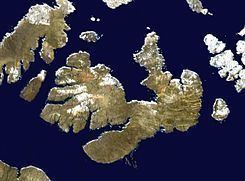Location Northern Canada Length 341 km (211.9 mi) Area 42,149 km² | Area rank 33rd Population 0 | |
 | ||
Width 210–292 km (130–181 mi) Territory Northwest TerritoriesNunavut Island groups Canadian Arctic Archipelago, Queen Elizabeth Islands | ||
Melville Island is an uninhabited island of the Canadian Arctic Archipelago with an area of 42,149 km2 (16,274 sq mi). It is the 33rd largest island in the world and Canada's eighth largest island. Melville Island is shared by the Northwest Territories, which is responsible for the western half of the island, and Nunavut, which is responsible for the eastern half. The border runs along the 110th meridian west. The mountains on Melville Island, some of the largest in the western Canadian Arctic, reach heights of 1,000 m (3,300 ft). There are two subnational pene-exclaves that lie west of the 110th meridian and form part of the Northwest Territories. These can only be reached by land from Nunavut or boat from the Northwest Territories.
Contents
Geography
The island has little or no vegetation. Where continuous vegetation occurs, it usually consists of hummocks of mosses, lichens, grasses, and sedges. The only woody species, the dwarf willow, grows as a dense twisted mat crawling along the ground. However, a diverse animal population exists: polar bear, Peary caribou, muskox, northern collared lemming, Arctic wolf, Arctic fox, Arctic hare, and ermine (stoat) are common. A 2003 sighting of a grizzly bear and grizzly tracks by an expedition from the University of Alberta represent the most northerly reports of grizzly bears ever recorded.
Melville Island is one of two major breeding grounds for a small sea goose, the brant goose. DNA analysis and field observations suggest that these birds may be distinct from other brant stocks. Numbering 4,000-8,000 birds, this could be one of the rarest goose stocks in the world.
History
The first European to visit Melville Island was the British explorer Sir William Parry in 1819. He was forced to spend the winter at what is now called "Winter Harbour", until August 1, 1820, owing to freeze-up of the sea. The island is named for Robert Dundas, 2nd Viscount Melville who was First Sea Lord at the time. In the search for Franklin's lost expedition, its east coast was explored as far as Bradford Point by Dr. Abraham Bradford in 1851, while its north and west coasts were surveyed by Francis Leopold McClintock, Richard Vesey Hamilton and George Henry Richards in 1853.
In 1930, a large sandstone rock marking Parry's 1819 wintering site at Winter Harbour, approximately 5.5 metres (18 ft) long and 3 metres (10 ft) high, was designated a National Historic Site of Canada.
Fossil fuel deposits
Melville has surfaced as a candidate for natural gas deposits. The island was believed to have deposits of coal and oil shale since the first half of the 20th century. The first Canadian Arctic island exploratory well was spudded in 1961 at Winter Harbour. It drilled Lower Paleozoic strata to a total depth of 3,823 m (12,543 ft). In the 1970s, the northern portion of the island on the east side of the Sabine Peninsula proved to contain a major gas field, known as Drake Point. The lease was owned by Panarctic Oils, a joint operation with the Canadian Government.
